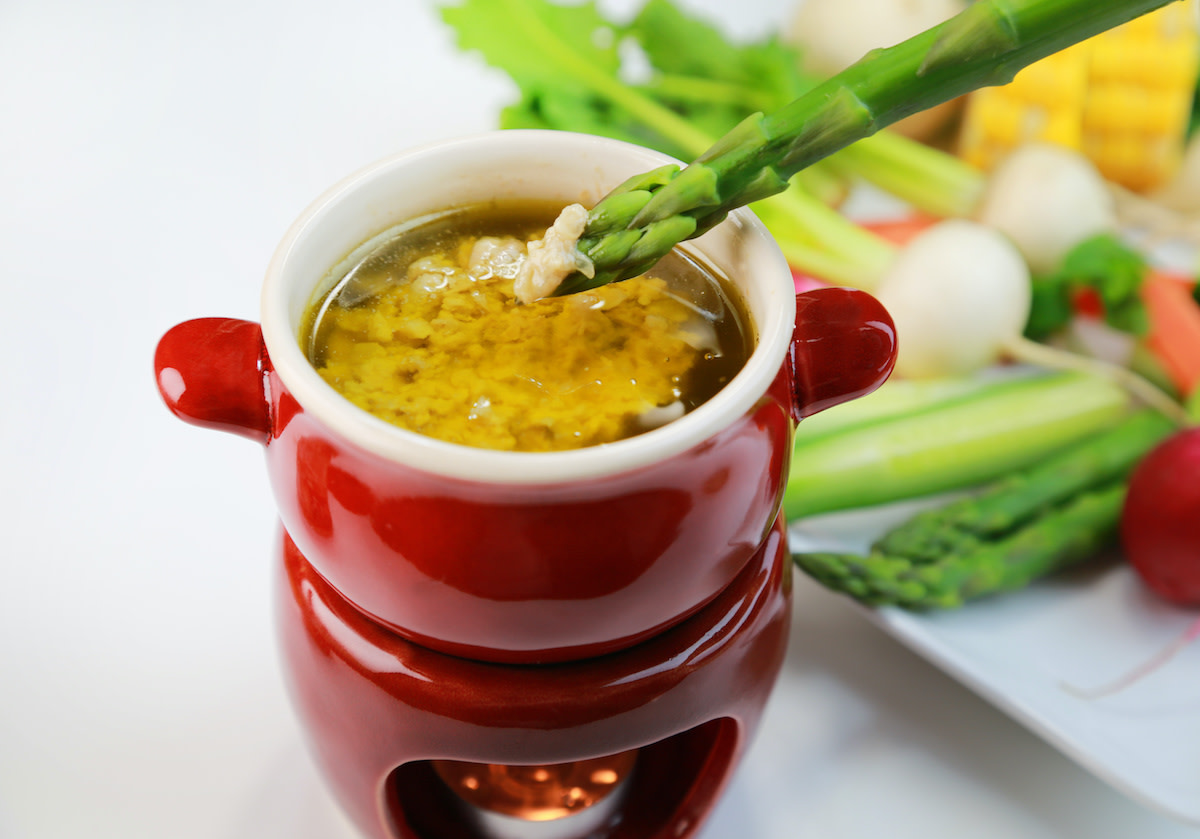Bagna Càuda Recipe: How to Make the Italian Dipping Sauce
Written by MasterClass
Last updated: Dec 23, 2025 • 3 min read
Lovers of anchovies and garlic might rejoice over bagna càuda, a fondue-like dipping sauce that is a traditional dish in the Piedmont region of Italy.
Learn From the Best
What Is Bagna Càuda?
Traditional to Italy’s Piedmont region, bagna càuda (Italian for “hot bath”) is a hot dip consisting of anchovy fillets, high-quality extra virgin olive oil, and plenty of garlic. Residents of Alba, Italy, make their classic version of bagna càuda with truffles. You can make bagna càuda on the stovetop, although traditional recipes call for extremely low heat and a terra-cotta cooking vessel soaked in water for 12 hours prior to cooking to prevent the dip from scorching. You can also make bagna càuda in a slow cooker.
How to Serve Bagna Càuda
Italians traditionally serve bagna càuda as an appetizer during the Christmas and New Year holidays and with a variety of foods for dipping into the hot sauce. To serve bagna càuda according to tradition, you can plate it with these usual accoutrements:
- Bread: Italian bread pairs well with bagna càuda. Slice the crusty bread and serve it warm. Slices of firm polenta are also a traditional Piedmontese accompaniment for bagna càuda.
- Cooked vegetables: Roasted vegetables can add contrasting flavors to the garlicky, fishy dip. Try roasted onions, leeks, cauliflower florets, zucchini spears, and slices of scallions, all of which are common dipping choices for bagna càuda.
- Raw vegetables: Traditional veggies to serve raw alongside bagna càuda include cardoons (edible thistle), endive, radishes, artichokes, fennel, bell peppers, and radicchio. Carrots and celery, as well as other raw vegetables usually found on a platter of crudités, can also make good options.
4 Variations of Bagna Càuda
Traditional Italian cooks use one head of garlic per person and the highest-quality oil and anchovies. However, there can be various additions to bagna càuda depending on the chef’s locality. Here are a few variations:
- 1. Bagna càuda with heavy cream: For a creamy version of the oily dip, add heavy cream. This variation is best prepared puréed to ensure the oil and heavy cream emulsify adequately. Heavy cream in bagna càuda most likely originated when the dish made it to France. In a recipe with heavy cream, add it off the heat to best avoid curdling or breaking.
- 2. Bagna càuda with truffles: It’s popular in the Alba area of Piedmont, Italy, to add truffles for an earthy flavor that offsets the brininess of the anchovies and the fattiness of the olive oil. Shave high-quality black or white truffles over the bagna càuda right before serving.
- 3. Bagna càuda with toasted nuts: Toasted, chopped hazelnuts provide a nice contrasting texture in the bagna càuda, especially if you also stir in a touch of hazelnut oil. Other nut options are almonds or walnuts.
- 4. Bagna càuda with walnut oil: The earliest bagna càuda recipes called for walnut oil and hazelnut oil instead of extra virgin olive oil. Make your own version by using these oils with or without olive oil.
Bagna Càuda Recipe
makes
prep time
0 mintotal time
20 mincook time
20 minIngredients
- 1
Soak the anchovies in the red wine for 10 minutes.
- 2
While the anchovies are soaking, remove the individual garlic cloves from all of the heads and chop them finely. (When choosing a head of garlic, look for a tight, papery skin, no sprouting, and no black spots.)
- 3
In a medium saucepan over low heat, add the olive oil and the wine-soaked anchovies. If the anchovies did not absorb all the wine, do not add the remaining liquid.
- 4
Mash the anchovies with the back of a wooden spoon to form a paste. Let the paste cook for about 5 minutes.
- 5
Add the finely chopped garlic and cook for an additional 5 minutes.
- 6
Turn off the heat and add in the butter, letting it melt in the residual heat.
- 7
Transfer the bagna càuda to a blender or food processor and puree it until it becomes homogenized for an extra-smooth consistency.
- 8
Transfer the bagna càuda to an electric skillet or fondue pot to keep it warm.
- 9
Serve the bagna càuda with raw veggies, roasted vegetables, firm polenta, or crusty Italian bread.
Become a better chef with the MasterClass Annual Membership. Gain access to exclusive video lessons taught by the world’s best, including Gordon Ramsay, Gabriela Cámara, Niki Nakayama, Chef Thomas Keller, Yotam Ottolenghi, Dominique Ansel, Alice Waters, and more.
